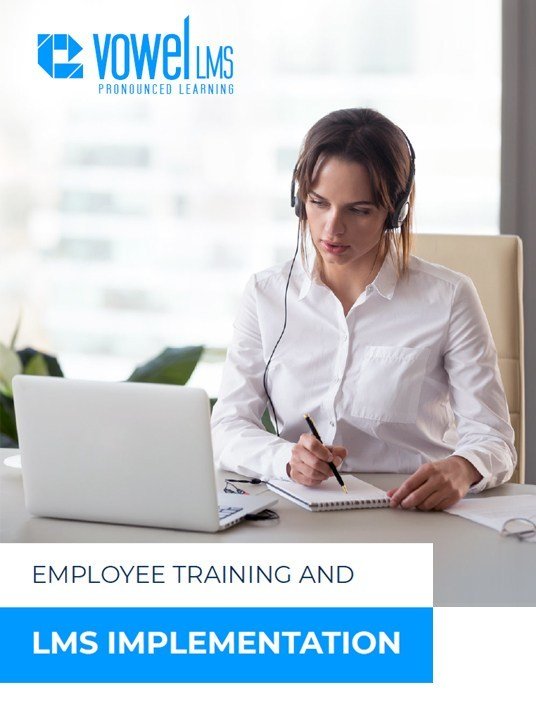Get The Most Out Of Your LMS
The worldwide LMS (Learning Management System) market size is slated to reach USD 22.4 billion by 2023. In addition to this, by the year 2020, 98% of the small businesses are planning to leverage the power of LMS to efficiently address their learning needs. Based on these statistics, it can be safe to say that nowadays, businesses can see the obvious and immediate benefits of investing in LMS.

For instance, an LMS can help collate and store all the essential materials in one place and help keep track of the employee performance for the organization. This data and insights gathered through the LMS can help organizations define and fine-tune their training and employee engagement initiatives and boost employee performance.
However, employee training through LMS is no cakewalk. It needs to be befitting for the organization and its needs and should offer long-term benefits. This takes us to the next question. How to achieve effective LMS implementation for better employee training ROI?
The answer lies in the following steps:
1. Choose Relevant Content
Content is king, and it is more valid for learning. The content should be customized to aptly fit the training needs of your employees and the goals of your organization. It needs to be in-sync with the employees’ job roles, their skill sets and should offer them value. It should be beneficial not just for the employees’ temporary job requirements, but also for their future career path. When they see the contribution of the training in their career paths, they will be more willing to complete the courses.
2. Make Content Discoverable
For any learning portal, it is an uphill task to make all the content easy-to-access and readily available at the users’ fingertips. The solution is to select a Learning Management System that lets the learners discover any content instantly—based on keywords, topics, or trainers. One of the quickest ways to get your target users’ attention to the course content is by automatically offering suggestions. These suggestions can be based on the most popular content, job-specific recommendations, interest-based, or selected by the system admin based on the last module that the learner completed. This will help them inch towards course completion.
3. Peer-To-Peer Recommendation
A peer-to-peer recommendation in an intrinsic feature of an effective LMS. It lends the system the ability to recommend the learning sessions to peers. For instance, learners can register their availability in the system as well as their preferences to provide learning support or seeking support. This can help them find study partners for various relevant topics in the course that match their interests. All the information can be presented in a graphical interface for quick reference. This support goes a long way in retaining the learners’ interest in the LMS and using it to acquire knowledge.
4. Take The Gamification Route
Gamification is one of the best options to take the learning experience several notches up. It not only engages the learners but also gives them incentives to implement the learning on the job. There are several ways to approach gamification, including creating several levels or challenges in the modules. Similarly, the modules can include elements like quizzes or real-life scenarios with appealing visuals that increase the fun factor for the learners. Moreover, these elements can be integrated with leaderboards and badges to show the learners their standing and achievements vis-à-vis their colleagues.
Gamification can be one of the most effective learning strategies to promote competitive learning and keep the employees motivated. With the fun elements and the sense of challenge, it also aids in knowledge retention.
5. Reward The Learners
Rewards foster a healthy learning culture. Therefore, implement a rewards system that can be intangible or tangible in nature. Think of a situation wherein a learner completes a module or scores high in a quiz or test. In this scenario, he or she can be given reward credits. After collecting a significant number of credits, they can exchange it for any reward of their choice (the rewards need to be specified to them in advance.) Also, make sure that their milestones reflect on the leaderboard as this will give them a sense of achievement.
6. Send Periodic Updates
Learners may leave a course midway for various reasons. This is where periodic updates can come to the organizations’ rescue. These updates will remind them about the course at regular intervals and motivate them to return and complete the modules. Similarly, the updates can also inform them about any upcoming modules or changes in an existing module. The updates can be delivered to the learners on their devices, via emails or through text or social updates.
7. Create Curated And Personalized Learning Curves
Everyone loves personalization, and learners are no different. They look for variety and personalized course modules along with an intuitive interface that makes it easy for them to complete the course. For this, you use AI (Artificial Intelligence), AR and VR tools and create immersive and interactive course modules based on the learners’ skills. Even video-based eLearning can be one of the options as it is an effective means to hold the learners’ attention. Ensure that the courses are tailored to meet specific job roles, and it will be good to go.
Effective LMS For The Win
The effective implementation of an LMS can be quite a bit of a challenge. But with the steps mentioned above and continuous feedback from the learners, it can become easier not just to implement it successfully, but also enhance employee training. It is all about making the system intuitive and complete with features and functionalities that give the learners an incentive to inch towards completion. That is how you can make the most out of investing a significant sum in blended learning systems.
Have a say? Let us know in the comments! Download the eBook The Complete LMS Implementation Guide To Ensure Employee Training Success to discover more about the successful implementation of an LMS for achieving better effects in your organization. Join the webinar to delve into the secrets behind a victorious LMS implementation.










